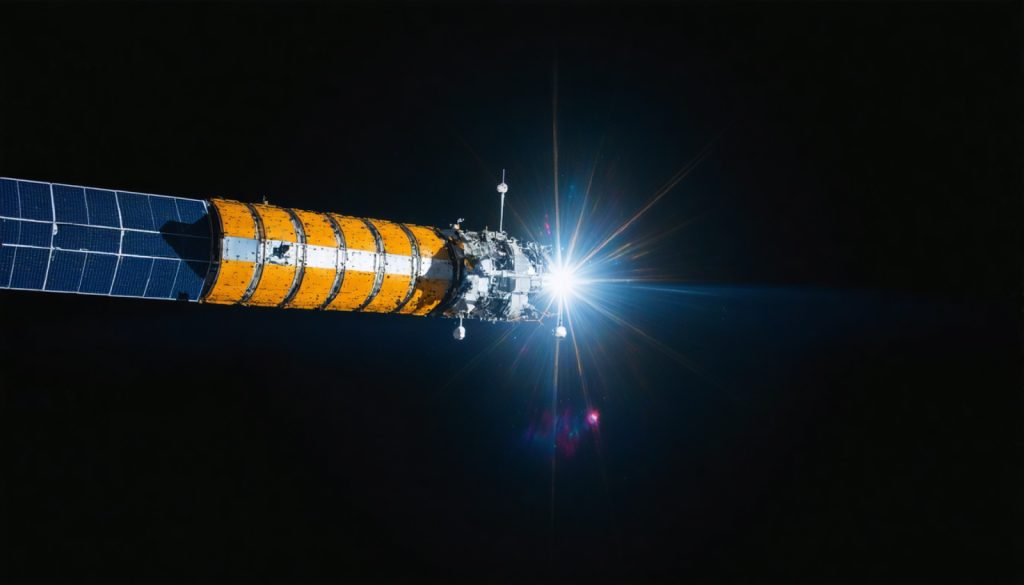
- GSAT-N2 is a pioneering communication satellite developed by the Indian Space Research Organisation (ISRO) to enhance global connectivity.
- The satellite aims to improve broadband connectivity and support next-generation networks across India, extending from remote areas to urban centers.
- Equipped with advanced propulsion and transponder technologies, GSAT-N2 promises superior signal quality and long-term operational efficiency.
- The satellite aligns with environmental goals by reducing the need for frequent launches through extended fuel efficiency and lifespan.
- GSAT-N2 is crucial for bridging the digital divide, fostering opportunities in education, healthcare, and commerce by linking previously unreachable regions.
- India’s investment in GSAT-N2 signifies a commitment to technological progress and global competitiveness in satellite communications.
In the shimmering vault of space, where nations vie for supremacy, India’s GSAT-N2 stands as a bold contender, ready to reshape communication landscapes. The GSAT-N2, an advanced communication satellite, emerges from the workshop of the Indian Space Research Organisation (ISRO), famed for its pioneering spirit and resilience. Though still conceptual, its potential is already stirring excitement and anticipation.
Crafted to Connect:
Picture a world where connectivity transcends barriers, reaching the most remote hamlets to bustling metros seamlessly. GSAT-N2 is engineered to revamp how we stay connected, promising to bolster broadband connectivity and support next-generation networks. Utilizing state-of-the-art technologies, it aims to enhance video and data transmission quality across vast geographies, making it indispensable for a connected India.
A Technological Marvel:
Visualize a marvel of engineering, glistening against the void, armed with transponders tasked with a mission to deliver sharp, uninterrupted signals. This satellite boasts cutting-edge propulsion systems, maximizing its lifespan and operational efficiency. Its design ensures adaptability, allowing it to meet the dynamic demands of future telecommunication needs.
Environmental and Economic Edge:
GSAT-N2 isn’t merely a tool for progress; it aligns with environmental responsibility. By optimizing fuel efficiency and extending its operational tenure, the satellite reduces the frequency of costly launches and associated carbon footprints. Economic narratives around GSAT-N2 speak of growth, as it promises to fuel digital economies while enhancing global competitiveness in satellite communications.
But Why It Truly Matters:
In an era of increasing digital dependency, the GNAT-N2 symbolizes India’s commitment to bridging the digital divide. It heralds a future where no geographical expanse is beyond reach, presenting unparalleled opportunities for education, healthcare, and commerce to thrive on the backbone of rock-solid connectivity.
Takeaway Message:
Harnessing technology to leap beyond terrestrial boundaries, GSAT-N2 is more than a satellite—it’s a beacon for transformation. By investing in such groundbreaking projects, nations not only advance technologically but also contribute to a more interconnected and inclusive world. As preparations for GSAT-N2 intensify, the world watches, keenly aware that this is only the beginning of a story filled with promise and potential. In the vast theater of space, India is poised to leap forward—a leap that echoes progress and possibilities not just for itself, but the entire globe.
The Future of Connectivity: Unveiling the Potential of India’s GSAT-N2 Satellite
Expanding on India’s GSAT-N2: A Frontier for Advanced Satellite Communication
The GSAT-N2 satellite, poised to become a cornerstone in India’s space ambitions, has prompted curiosity about its full potential. While the Indian Space Research Organisation (ISRO) has laid out its vision, there’s more to uncover about the impact and capabilities of this advanced communication satellite.
How GSAT-N2 Transforms Connectivity
Envisioned to overcome connectivity barriers, GSAT-N2 is set to enhance broadband access throughout India, focusing on rural and remote locations. This satellite will leverage advanced frequency bands, such as Ka and Ku band-spectrum, which are less congested and allow for higher data throughput compared to conventional spectrum bands.
Life Hacks & How-to Steps to Maximize its Use:
1. Rural Broadband Initiatives: Local governments can partner with ISRO to integrate GSAT-N2 capabilities into existing frameworks for rural internet access.
2. Educational Platforms: Utilize GSAT-N2’s connectivity for e-learning portals, offering consistent access to educational resources.
3. Telemedicine: Healthcare providers can deploy this technology to reach underserved areas, allowing remote consultations and diagnostics.
Exploring the Technological Innovations
GSAT-N2 is a breakthrough with its electric propulsion systems, which significantly reduce fuel requirements and extend mission duration compared to traditional chemical propulsion. Incorporating advanced heat-dissipation mechanisms ensures optimal performance under varied temperature conditions in space.
Security & Sustainability Considerations
Security is paramount for GSAT-N2, equipped with encryption technologies to secure data transmissions against cyber threats. Its sustainable design contributes minimally to space debris and environmental impact on Earth, reflecting ISRO’s commitment to responsible space exploration.
Industry Trends and Market Forecasts
The global satellite telecommunications market is projected to reach new heights. According to a report by Research and Markets, the satellite communication market will grow from $62.19 billion in 2021 to $99.59 billion by 2026, driven by increased demand for broadband and 5G infrastructure. GSAT-N2 positions India to capture part of this expanding market.
Addressing Controversies and Limitations
While satellites are crucial for connectivity, they face limitations such as signal latency and potential interference with terrestrial systems. Policies need to address these challenges, ensuring GSAT-N2’s integration without compromising other communications infrastructures.
Pros & Cons: Overview
– Pros:
– Extensive coverage even in remote areas.
– Supports high-capacity data transmission.
– Environmentally-conscious design.
– Cons:
– Higher initial cost.
– Potential interference challenges.
– Dependence on favorable orbital conditions.
Conclusion and Recommendations
GSAT-N2 represents India’s move towards a digitally inclusive future, promising unprecedented advancements in connectivity. Governments and organizations should strategize to incorporate satellite Internet technologies into their infrastructure to overcome existing connectivity barriers.
Quick Tips:
– Collaborate with ISRO for regional connectivity initiatives.
– Develop applications reliant on stable satellite broadband for healthcare and education.
– Monitor space industry trends to leverage advancements in satellite communications efficiently.
For further information on ISRO’s initiatives, visit the ISRO official website.



